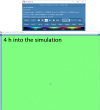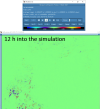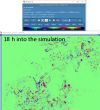Hello,
I would like to investigate the effects of continuously injecting moisture into the atmosphere at the surface at a specific grid point during a multi-day mesoscale WRF simulation. The moisture should be added throughout the entire run (e.g., at every time step or hourly), not just at initialization. It is also important that the added moisture is fully incorporated into the model's dynamics and physics.
Initially, I considered simply increasing the latent heat flux (LH), but I’m not sure if that would achieve the desired effect.
Are there any guidelines or recommended methods for implementing this? Any advice or experience with similar modifications would be greatly appreciated.
Many thanks in advance,
Akos
I would like to investigate the effects of continuously injecting moisture into the atmosphere at the surface at a specific grid point during a multi-day mesoscale WRF simulation. The moisture should be added throughout the entire run (e.g., at every time step or hourly), not just at initialization. It is also important that the added moisture is fully incorporated into the model's dynamics and physics.
Initially, I considered simply increasing the latent heat flux (LH), but I’m not sure if that would achieve the desired effect.
Are there any guidelines or recommended methods for implementing this? Any advice or experience with similar modifications would be greatly appreciated.
Many thanks in advance,
Akos



